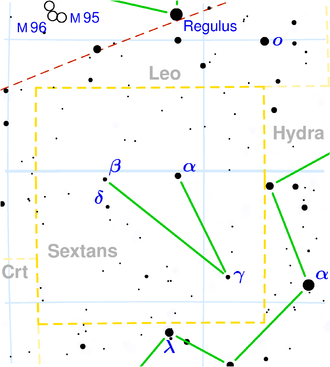NGC 2990
| Galaxy NGC 2990 |
|
|---|---|

|
|
| SDSS recording | |
| AladinLite | |
| Constellation | sextant |
|
Position equinox : J2000.0 , epoch : J2000.0 |
|
| Right ascension | 09 h 46 m 17.1 s |
| declination | + 05 ° 42 ′ 32 ″ |
| Appearance | |
| Morphological type | Sc: |
| Brightness (visual) | 12.6 mag |
| Brightness (B-band) | 13.3 mag |
| Angular expansion | 1.1 ′ × 0.6 ′ |
| Position angle | 85 ° |
| Surface brightness | 12.0 mag / arcmin² |
| Physical data | |
| Redshift | 0.010300 ± 0.000017 |
| Radial velocity | 3088 ± 5 km / s |
|
Stroke distance v rad / H 0 |
(132 ± 9) x 10 6 ly (40.5 ± 2.8) Mpc |
| history | |
| discovery | William Herschel |
| Discovery date | December 29, 1786 |
| Catalog names | |
| NGC 2990 • UGC 5229 • PGC 28026 • MCG + 01-25-021 • IRAS 09436 + 0556 • 2MASX J09461721 + 0542318 • GC 1914 • H II 624 • | |
NGC 2990 is a spiral galaxy of the Hubble type Sc: in the constellation Sextant at the celestial equator . It is estimated to be 132 million light years from the Milky Way and about 50,000 ly in diameter.
The object was discovered on December 29, 1786 by the astronomer William Herschel with a 48 cm telescope.
